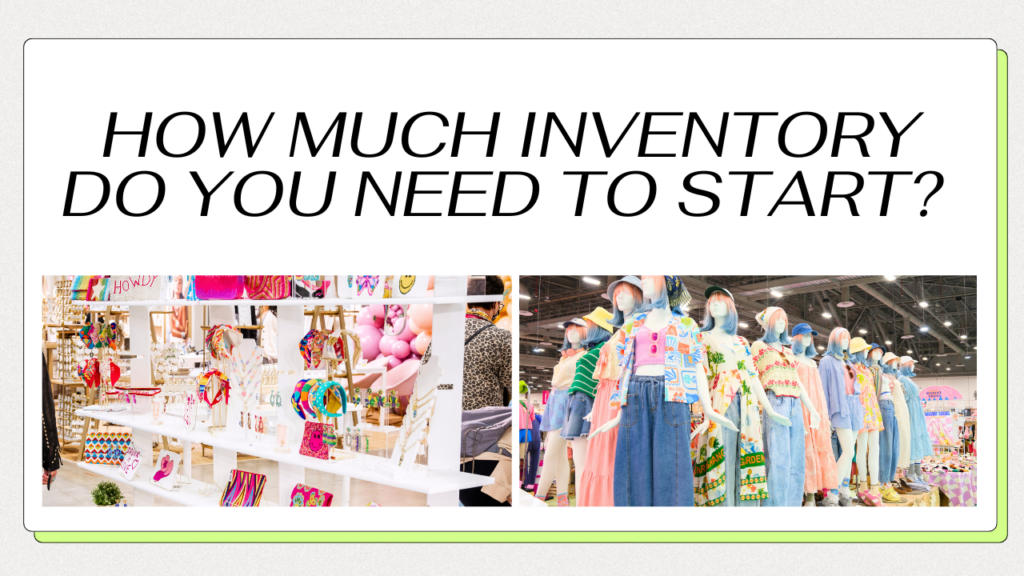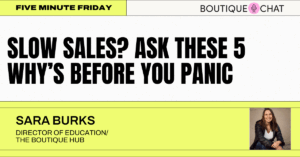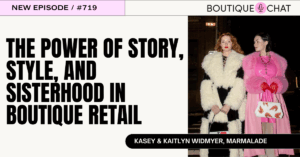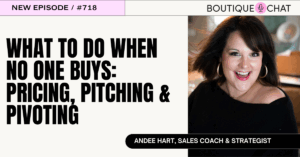Starting a boutique is an exciting venture, but one of the biggest questions new boutique owners face is: how much inventory do I need? The answer isn’t one-size-fits-all, as it depends on your business model, budget, and customer demand. However, having a strategic approach to inventory planning can set you up for success from day one.
Want an in-depth guide on determining the right amount of inventory to start with? Download our FREE guide here: How Much Inventory Do I Need to Start?
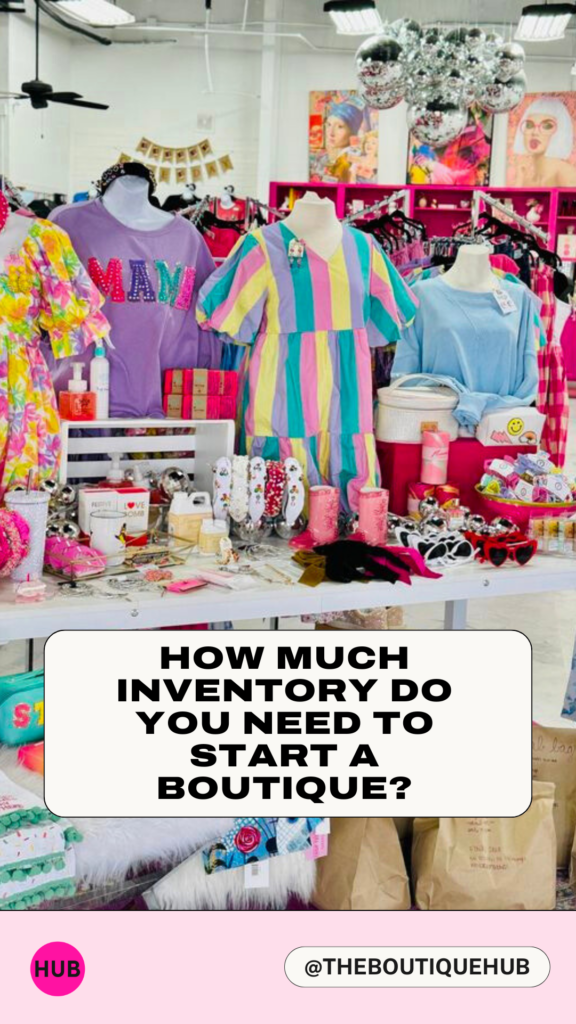
Factors to Consider When Buying Inventory
1. Your Boutique’s Business Model
- Brick-and-Mortar Boutique: If you’re opening a physical store, you’ll need enough inventory to fill your space without overwhelming it. A well-stocked boutique creates an inviting shopping experience, but too much inventory can lead to clutter and excess stock.
- Online Boutique: Without the constraints of a physical location, you can start with a smaller, curated selection. You may choose a pre-order or drop-shipping model to minimize upfront inventory costs.
- Pop-Up Shop or Market Events: If you’re selling at events or pop-ups, your inventory should be tailored to fit the theme, season, and expected foot traffic.
2. Determine Your Inventory Categories
To create a well-rounded boutique collection, start by breaking your inventory into key categories:
- Tops: Blouses, casual tops, sweaters, layering pieces, blazers
- Bottoms: Jeans, skirts, shorts, slacks
- Dresses: Casual, special occasion, seasonal, rompers
- Outerwear: Jackets, coats, vests
- Accessories: Scarves, hats, socks
- Jewelry: Necklaces, rings, bracelets
- Home Decor & Gifts: Candles, stationery, prints, baskets, journals, seasonal items
3. Establish an Inventory Breakdown
Where do you predict your sales to come from? A general rule for new boutiques is that 50% of your inventory should focus on the top half of the body, as these items tend to get more compliments and are easier to sell.
Here’s an example of a starting inventory budget allocation:
- Tops: 50%
- Jewelry: 15%
- Accessories: 15%
- Bottoms: 10%
- Outerwear: 5%
- Home Decor & Gifts: 5%
4. Start with Sales Projections
Estimate your first 3-6 months of sales based on expectations, market research, or similar businesses.
Use this formula to calculate projected monthly sales: Projected Monthly Sales = Average Order Value × Expected Foot Traffic or Online Orders
For example, if you expect 300 transactions per month at an average order value of $50, your projected monthly sales would be $15,000.
5. Determine Your Inventory Investment
Your starting inventory should be 2.5 to 3 times your projected monthly sales to ensure you have enough stock while allowing room for new arrivals.
For example, if your projected monthly sales are $30,000, your initial inventory should be valued at $75,000 – $90,000 at retail price. Depending on your markup, you can then determine your wholesale investment.
How to Avoid Overstocking
Buying too much inventory can tie up your cash flow and lead to markdowns. To prevent overstocking:
- Start with 1-2 packs per style and restock bestsellers.
- Use pre-order or waitlist strategies to gauge interest before making bulk purchases.
- Monitor sales trends and adjust your buying strategy accordingly.
Final Thoughts
Starting a boutique with the right amount of inventory requires a balance between variety and financial sustainability. Begin with a curated selection, track your sales, and adjust as needed. With strategic inventory planning, you can grow a successful boutique that keeps customers coming back for more!
Ready to take the guesswork out of inventory planning? Download our FREE guide here: How Much Inventory Do I Need to Start?
Need help sourcing inventory? Check out Hubventory for exclusive wholesale collections and trending styles perfect for your boutique!
Get more information on growing your business by joining The Boutique Hub where we have tons of training, strategies, and most importantly, connection! Try out our service for a month, cancel anytime.
- Slow Sales? Ask These 5 Why’s Before You Panic
 Is your cash flow feeling tight but you’re still not paying yourself? In this episode of Five Minute Friday, Sara breaks down one of the most common retail traps: tying up cash in things that don’t bring you a return. From unnecessary trips to market to unused apps, pretty packaging, and impulse inventory buys, these hidden money leaks could be holding your business (and paycheck!) back.
Is your cash flow feeling tight but you’re still not paying yourself? In this episode of Five Minute Friday, Sara breaks down one of the most common retail traps: tying up cash in things that don’t bring you a return. From unnecessary trips to market to unused apps, pretty packaging, and impulse inventory buys, these hidden money leaks could be holding your business (and paycheck!) back. - The Power of Story, Style, and Sisterhood in Boutique Retail
 Ever wonder what it takes to turn a family passion into a thriving business? Join us as we chat with Kasey & Kaitlyn Widmyer, the dynamic duo behind Marmalade, a boutique inspired by their mother, Marie Widmeyer, and her fashion dreams. From childhood lessons to steering the business through the storms of the 2007-2008 recession, they share how these experiences crafted their resilience and work ethic. Get ready to be inspired as they recount their journey from playtime in the boutique aisles to orchestrating its expansion after college, proving that perseverance and adaptability can indeed breed success even in the most challenging economies.
Ever wonder what it takes to turn a family passion into a thriving business? Join us as we chat with Kasey & Kaitlyn Widmyer, the dynamic duo behind Marmalade, a boutique inspired by their mother, Marie Widmeyer, and her fashion dreams. From childhood lessons to steering the business through the storms of the 2007-2008 recession, they share how these experiences crafted their resilience and work ethic. Get ready to be inspired as they recount their journey from playtime in the boutique aisles to orchestrating its expansion after college, proving that perseverance and adaptability can indeed breed success even in the most challenging economies. - Back to School Marketing Ideas
 Back to school season is the second busiest shopping season of the year! How are you going to capitalize this year? This time of year is going to be here before we know it, so its time to get busy prepping! Back to school time is a perfect opportunity to host an event or run a sale to attract new customers for the busy shopping season. Lets get into our top back to school marketing ideas!
Back to school season is the second busiest shopping season of the year! How are you going to capitalize this year? This time of year is going to be here before we know it, so its time to get busy prepping! Back to school time is a perfect opportunity to host an event or run a sale to attract new customers for the busy shopping season. Lets get into our top back to school marketing ideas! - What to Do When No One Buys: Pricing, Pitching & Pivoting
 What if sales didn’t have to be about being pushy or intimidating, but instead about solving problems and making life better? Join us as we explore this concept with our guest, Andee Hart, who transformed her corporate sales expertise into a flourishing candle business during the pandemic. Andee’s inspiring journey is a masterclass in differentiation and tenacity, from how she successfully stood out in a crowded market to how she scaled her business to hundreds of boutiques.
What if sales didn’t have to be about being pushy or intimidating, but instead about solving problems and making life better? Join us as we explore this concept with our guest, Andee Hart, who transformed her corporate sales expertise into a flourishing candle business during the pandemic. Andee’s inspiring journey is a masterclass in differentiation and tenacity, from how she successfully stood out in a crowded market to how she scaled her business to hundreds of boutiques. - Top 10 Mistakes Retailers Make (And How Retail Bootcamp Helps You Avoid Them)
 Running a boutique business can be one of the most rewarding—and challenging—adventures. Whether you’re just starting your boutique or you’ve been in business for years, it’s easy to fall into common traps that hold your growth back. The good news? You’re not alone—and you don’t have to figure it out on your own either. That’s where Retail Bootcamp comes in. This proven boutique coaching program is designed to help boutique owners like you grow smarter, more profitably, and with a clear plan in place.
Running a boutique business can be one of the most rewarding—and challenging—adventures. Whether you’re just starting your boutique or you’ve been in business for years, it’s easy to fall into common traps that hold your growth back. The good news? You’re not alone—and you don’t have to figure it out on your own either. That’s where Retail Bootcamp comes in. This proven boutique coaching program is designed to help boutique owners like you grow smarter, more profitably, and with a clear plan in place.

